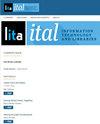紧急远程库指令和技术工具
IF 1.5
4区 管理学
Q3 COMPUTER SCIENCE, INFORMATION SYSTEMS
引用次数: 10
摘要
2020年春季,由于新冠肺炎疫情,紧急远程教学成为美国数百所高等教育机构的常态。图书馆员突然被要求将面对面的服务和资源转移到网上。对于负有教学职责的图书馆员来说,这项在线任务意味着在同步和异步会话之间做出决定,学习新技术和工具进行主动学习,并审查这些工具的安全问题和ADA合规性。为了了解我们在紧急远程教学方面的共同和独特经验,作者调查了202名学术指导图书馆员,以回答以下问题:(1)在新冠肺炎期间,学术图书馆员使用哪些技术工具来提供内容并让学生参与紧急远程图书馆会议?(2) 教学馆员认为这些工具的优点和缺点是什么?(3) 教学馆员目前正在确定哪些数字素养差距,这些差距可能会阻碍在线获得公平的信息素养教学?这项研究将提供和讨论调查结果,并就利用技术工具的最佳实践提出建议,并对其进行公平性和学生参与度评估。本文章由计算机程序翻译,如有差异,请以英文原文为准。
Emergency Remote Library Instruction and Tech Tools
During spring 2020, emergency remote teaching became the norm for hundreds of higher education institutions in the United States due to the COVID-19 pandemic. Librarians were suddenly tasked with moving in-person services and resources online. For librarians with instruction responsibilities, this online mandate meant deciding between synchronous and asynchronous sessions, learning new technologies and tools for active learning, and vetting these same tools for security issues and ADA compliance. In an effort to understand our shared and unique experiences with emergency remote teaching, the authors surveyed 202 academic instruction librarians in order to answer the following questions: (1) What technology tools are academic librarians using to deliver content and engage student participation in emergency remote library sessions during COVID-19? (2) What do instruction librarians perceive as the strengths and weaknesses of these tools? (3) What digital literacy gaps are instruction librarians identifying right now that may prevent access to equitable information literacy instruction online? This study will deliver and discuss findings from the survey as well as make recommendations toward best practices for utilizing technology tools and assessing them for equity and student engagement.
求助全文
通过发布文献求助,成功后即可免费获取论文全文。
去求助
来源期刊

Information Technology and Libraries
管理科学-计算机:信息系统
CiteScore
2.90
自引率
5.60%
发文量
25
审稿时长
1 months
期刊介绍:
Information Technology and Libraries publishes original material related to all aspects of information technology in all types of libraries. Topic areas include, but are not limited to, library automation, digital libraries, metadata, identity management, distributed systems and networks, computer security, intellectual property rights, technical standards, geographic information systems, desktop applications, information discovery tools, web-scale library services, cloud computing, digital preservation, data curation, virtualization, search-engine optimization, emerging technologies, social networking, open data, the semantic web, mobile services and applications, usability, universal access to technology, library consortia, vendor relations, and digital humanities.
 求助内容:
求助内容: 应助结果提醒方式:
应助结果提醒方式:


